Taking Shape
A report from the birthplace of the Hare Krsna movement.
by Mandalesvara dasa
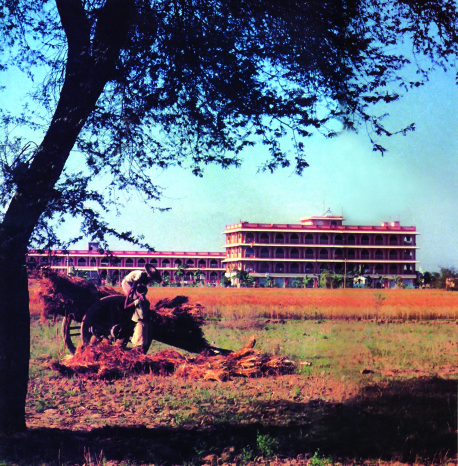
On a verdant stretch along the bank of the Ganges, in India’s province of West Bengal, lies the village of Mayapur. As history shows, Mayapur has long been a center for spiritual understanding and culture. Here, in 1486, Sri Krsna Caitanya appeared. Some four and one-half thousand years earlier, the Vedic literatures had predicted Lord Caitanya’s appearance, described Him as the Supreme Personality of Godhead, and pointed out that the land of His birth and pastimes is imbued with His own sublime spiritual qualities.
More recently, about a hundred years ago, the great spiritual master Bhaktivinoda Thakura predicted that one day people from all over the world would come to Mayapur and join together, singing jaya sacinandana! jaya sacinandana! “All glories to Lord Caitanya, the son of Saci!” Through the efforts of His Divine Grace A.C. Bhaktivedanta Swami Prabhupada, that prediction is fulfilled each year: ISKCON devotees from thirty countries meet in Mayapur to glorify Lord Caitanya on His appearance day.
Fifty years ago, Srila Bhaktisiddhanta Sarasvati Thakura (the son of Bhaktivinoda Thakura and spiritual master of Srila Prabhupada) envisioned a great spiritual city at Mayapur with many temples and thousands of devotees, all focused on the Krsna conscious ideal. Thanks again to Srila Prabhupada, the dream of a spiritual city is now coming true.
Getting Started
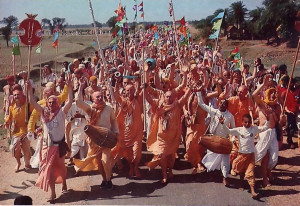
In 1971 Srila Prabhupada asked two of his senior disciples, Jayapataka Svami and Bhavananda Gosvami, to take charge of developing the Mayapur project. Jayapataka Svami relates how it all began….
“His Divine Grace asked me to come to India in 1970. At that time there weren’t many other Godbrothers from the West who were staying in India; I think Acyutananda Svami was there, and maybe five or six others. No sooner did I get to India than Srila Prabhupada said he wanted to purchase land in Mayapur, the birthplace of Lord Caitanya. So a few of us came here and began looking over the open fields and trying to find a farmer who would sell us a plot of land. That was our first business—to get land—and then we had to build a place to Stay. Srila Prabhupada had said, ‘If you don’t have a place to sit, you won’t have the proper perspective, but if you have a place to sit, then you can arrange everything.’ So we got our first piece of land, and Acyutananda Svami built a grass hut. By the end of 1971, I started living permanently in Mayapur.”
“It was our first piece of land here in Mayapur,” Bhavananda Gosvami explains. “It was only about three and one-half acres—just a narrow strip—but Srila Prabhupada had plans to develop every foot of it. He was designing a whole complex. He wanted us to get more land and eventually build a huge temple surrounded by four buildings one thousand feet long.”
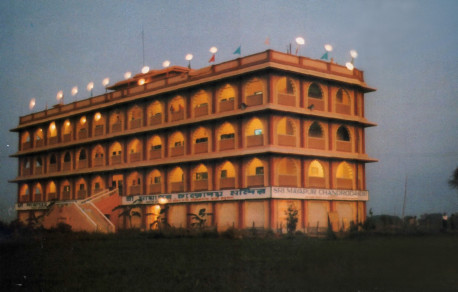
The first step was to construct a four-story guesthouse. Of course, for a handful of devotees ninety miles from Calcutta, constructing a four-story building in the middle of the rice fields of West Bengal was a difficult task.
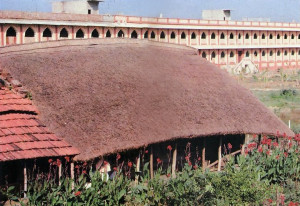
Bhavananda Gosvami relates, “I used to travel back and forth between Mayapur and Calcutta, bringing building materials by train and bus about twice a week. Sometimes I’d have to ride on the top of the bus with bales of wire. We had no car. At first there wasn’t even any electricity. And none of us knew anything about construction. I’d never even thought of constructing a building. I used to be a textile designer and in the movie business. What did I know about constructing such a big building?
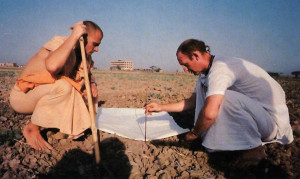
“I remember, one afternoon, walking on the property with Tamala Krsna Gosvami, who at that time was Srila Prabhupada’s coordinator for all our projects in India. He said, ‘Well, I don’t know how to build a building, but I’m determined that somehow we can do it.’ Srila Prabhupada had been saying, ‘Why are you making this construction into something difficult? It’s only a pile of bricks. Employ men for piling up the bricks, and you sit there and supervise—finished.’ So we all became very determined, and Tamala Krsna said, ‘Let’s try it.’ We got some men, and we measured out an area. Tamala Krsna was walking around and directing—’You do this, you do that.’
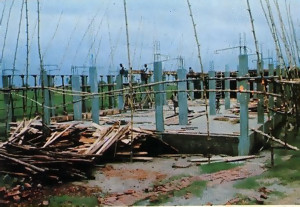
“Finally, we erected a little brick building. Srila Prabhupada was very pleased. It was completely in the wrong place—but at least we had made a start. From then on Srila Prabhupada directed us. But we had to act. As soon as we endeavored, then we could see things more and more clearly. The more we did, the clearer everything became—clear enough so that we could see our mistakes and correct them. Better you make a mistake than do nothing at all.”
“We hired a labor contractor and local villagers,” Jayapataka Svami explains, “and we had our own engineers supervise. Meanwhile, we purchased all the materials ourselves, which often meant transporting them from Calcutta. So our first year’s work here was to constantly purchase materials and supervise the construction.”
Prior to the completion of the first building, Srila Prabhupada came to Mayapur. “Since the building was still unfinished,” Jayapataka says, “Srila Prabhupada moved into the grass hut. At that time Srila Prabhupada commented, ‘For spiritual life, living in a grass hut is very conducive. For our own spiritual advancement we do not require big buildings. This grass hut is in the mode of goodness, but modern technology is in the mode of passion. For our own spiritual life, the mode of goodness is more important.’
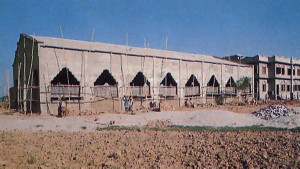
“So why were we working so hard to erect such a large, modern building? The reason is, Srila Prabhupada wanted to make it very simple for anyone from any part of the world to visit the holy land of Sri Mayapur, chant Hare Krsna, meditate on his relationship with the Supreme Lord, and taste the nectar of spiritual life. So to offer the world the transcendental mercy of Lord Caitanya, we had to have these buildings.”
This is an important idea. A Krsna conscious person should not reject material things that help his spiritual development or the spiritual development of others. It is better to utilize wealth in the service of the Lord. Bhavananda Gosvami explains it in this way….
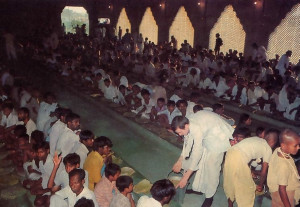
“When I first came here’, no one was visiting Mayapur. Such an important place of pilgrimage—yet no one was coming! Then, Srila Prabhupada gave us instructions to construct this big building costing millions of rupees. And he kept saying how it would accommodate thousands of people. All I saw was rice fields; I was puzzled—where were the thousands of people? But as the project developed, more and more visitors came to see us, to take prasada [spiritual food], and to offer respects to the Deities of Lord Caitanya and Radha-Madhava. And the festivals—at our last festival we fed nearly fifteen thousand people in one day! The more we develop this project, the more the people want to come here. If we had simply stayed in that hut and kept to ourselves, no one would have come and no one would have benefited.”
A Charming Culture

The citizens of West Bengal are inspired to see people from all over the world following India’s original Krsna conscious culture and coming to taste the nectar of Krsna consciousness for themselves. The Bengali devotees take this as a source of personal pride.
“In a word,” says Bhavananda Gosvami, “they’re charmed. The people of India are now looking to the highly materialistic, technologically advanced countries like America. But when they see that the Americans and Europeans are coming here to learn India’s spiritual culture, they are completely charmed. To these people it is a great compliment—’These Westerners are taking up our culture.’ You hear it all the time: ‘They’re taking up our culture—and we’re giving it up to follow the Western countries?’ They stop and think. They are completely charmed that we’re following this Krsna conscious culture, and they start turning their heads back to their own heritage. In this way, Srila Prabhupada is preserving India’s real treasure. Actually, India is the last stronghold of spiritual culture in the world.”
It is not that Krsna consciousness is something Indian. Actually, Krsna consciousness transcends the boundaries of East and West.
“In the Vedic literatures,” explains Jayapataka Svami, “Lord Krsna is compared to the sun—and the sun is neither Indian nor Western. If the sun appears over my head and I’m in India, I can’t claim that the sun is Indian. The sun is in such a superior position that it can’t be limited like that. In the same way, Lord Krsna is in everyone’s heart, so Krsna consciousness is universal. It’s meant to be practiced all over the world, not simply in India. Our consciousness is now impure, and we think ‘I’m Indian’ or ‘I’m American.’ But when our consciousness is purified, it is called Krsna consciousness—’I am a servant of Krsna.’ So anyone can live or teach this culture anywhere in the world. It’s meant for everyone.”
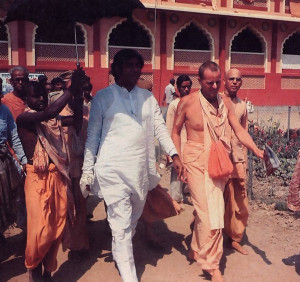
In a Krsna conscious cultural setting, society works smoothly with four natural divisions: brahmanas, ksatriyas, vaisyas, and sudras. The brahmanas give direction, education, and spiritual knowledge. The ksatriyas govern and give protection to the other classes. The vaisyas produce food and raise and protect the cows. And the sudras give assistance to the three higher classes. This social division is not a hereditary caste system. The Vedic literatures recommend that each individual’s role in society be based on his qualifications, not on the family in which he was born. The Mayapur community holds true to this original Vedic standard, and each individual adopts the occupation for which he is most naturally suited. It is not a matter of heredity, but of propensity. Following this system keeps the social body in proper working order. We know that even in our own bodies the head directs, the arms defend, the belly sustains, and the legs give menial service. And the social body has the same kind of natural divisions: the brahmanas function as the head, the ksatriyas as the arms, the vaisyas as the belly, and the sudras as the legs.
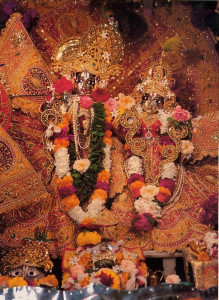
“In our community at present,” says Jayapataka Svami, “you’ll see the seedlings or beginning stages of the four basic social divisions. We have primary and secondary education for about a hundred full-time resident students. We have a dairy, agricultural fields, and orchards. We have a handloom center that engages about fifty resident workers. Cooks, priests, teachers, students, administrators, farmers—gradually we’re developing every occupational division of our society.”
Clearly, the Mayapur community differs vastly from most others—especially in the planning and organization behind it. This community engages everyone in his natural occupation, with Krsna as the center. Whatever occupation you perform, you can do it in a spirit of devotion to the Lord and in a Krsna conscious atmosphere. There will be no slaughterhouses and no brothels, nightclubs, or gambling casinos. These things simply destroy the finer sentiments of the human being.
“We have industries,” says Jayapataka Svami, “but they’re small-scale cottage industries that can be run without big factories, pollution, and hellish working conditions. In our Mayapur-candrodaya community, the residents work under very pleasant conditions, with beautiful natural scenery, trees, parks, lakes, and the chanting of Hare Krsna.”
“The atmosphere here is conducive to spiritual life,” explains Bhavananda Gosvami, “and everyone can work according to his natural propensity. That’s because, despite centuries of foreign rule and today’s materialistic trend, the Bengalis still respect Vedic culture. Here the people are pious. This is a place to begin showing the world a perfect Krsna conscious society.”
Relief for the Hungry
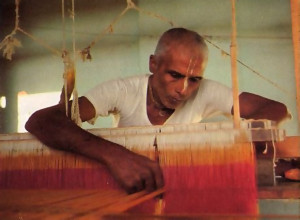
For thousands of families in the Mayapur area, hunger remains a problem. Over the past twenty-five years, huge numbers have migrated to the area from nearby Bangladesh.
Naturally, one vital and popular function of the Mayapur-candrodaya community has been free distribution of food—not just “food,” actually, but prasada—vegetarian food cooked with devotion and offered to Lord Krsna. By accepting prasada, one not only satisfies his hunger but also makes spiritual progress. Of course, hunger is only one kind of suffering to which man is heir. We all encounter many miseries in life, and their root cause is our past sinful acts. But by accepting prasada, food offered to the Lord, we are freed not only from our hunger but also from the suffering that was awaiting us due to our karma. This is the great benefit of distributing or accepting prasada
Jayapataka Svami was in Mayapur at the time Srila Prabhupada decided to institute the ISKCON Food Relief program.

“I remember the day right after we moved into our first building,” Jayapataka says. “Srila Prabhupada was in his room on the second floor. We’d had a big feast that day for several hundred guests. After the feast the banana leaf plates were thrown, as usual, into a garbage pit near the main building. After a while we heard some commotion, and Srila Prabhupada looked out the window. Outside he saw a group of village children picking through the garbage pit and eating the morsels of food that were left sticking to the plates. Srila Prabhupada’s eyes became filled with tears. He said, ‘How very hungry these people are—they are going to such trouble just to get some scraps of food! This is the house of God, the house of Krsna—so everyone who comes here to their Father’s house should be provided with a meal.’
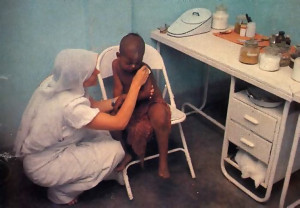
“So that’s when we started ISKCON Food Relief. ISKCON temples from all over the world came forward with donations to begin the food relief program. That was also when we decided to build our large dining pavilion for feeding fifteen hundred people at a time.
“Our mass prasada distribution program has been going on ever since. We feed about twenty thousand people in an average month, and on special occasions like the appearance day celebration of Lord Caitanya, we feed as many as fifteen thousand people in a day.
“Last year the CARE organization and the West Bengal Council for Child Welfare (of which we’re a corporate member) helped us to expand our program. With food provided by CARE, we can feed an additional 1,850 mothers and children.”
Books Are the Basis
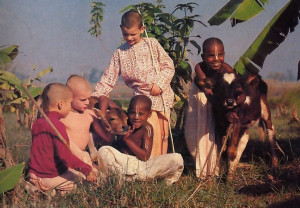
Srila Prabhupada’s disciples are establishing Krsna conscious culture not only within their own community but also throughout West Bengal and all of India. The ISKCON devotees man a fleet of four minibuses and one boat and travel throughout the state to hold public meetings and distribute literature on the science of Krsna consciousness. The Eastern India division of the International Bhaktivedanta Book Trust, with offices at ISKCON’s Mayapur center, prints Bengali and Hindi translations of the Vedic literatures and a monthly magazine entitled Bhagavat-darsana. Srila Prabhupada’s Bengali version of the Bhagavad-gita is especially popular and is fast becoming a classroom text in the primary schools.
Distribution manager Pancaratna dasa comments on book distribution in West Bengal: “The people here respect Srila Prabhupada’s books. Recently I was in Calcutta, and I was surprised to see that everywhere I went, people approached me for books: ‘You have books? Where is your temple? Can I get books there?’ They know what these books are, and they respect them.”
Soon after a van of book distributors travels to a new area, the mail starts coming in to Pancaratna, in Mayapur. “We can trace the town-to-town course of any team of book distributors,” he says, “simply by the mail we receive that week. People write to ask for subscriptions to our Bengali magazine. Or they want to write articles or ask for more books. And often they travel here to see us. In the past two weeks seventeen young Bengali men have joined our community. And they all come with Srila Prabhupada’s books in their hands.”
The natural respect for the ancient Krsna conscious culture reawakens in the hearts of India’s people when they read Srila Prabhupada’s books. So Bhagavad-gita distribution is as important as developing the city. The two programs complement each other.
The devotees also spread the Krsna conscious message by boat. In West Bengal many thousands of villagers can be reached more easily that way. On Nitai-pada-kamala, a fifty-foot sloop, the devotees travel to these interior villages, distribute prasada and Vedic literature, and chant Hare Krsna.
The devotees are seeing the people of India express their devotion for Lord Krsna more and more. Lord Caitanya Mahaprabhu predicted that people all over the world would reawaken to their natural Krsna consciousness. And He especially requested that everyone born in India first make his life perfect and then help spread Krsna conscious culture worldwide. The Lord’s mission is within the heart of everyone in the Mayapur-candrodaya community.

Leave a Reply